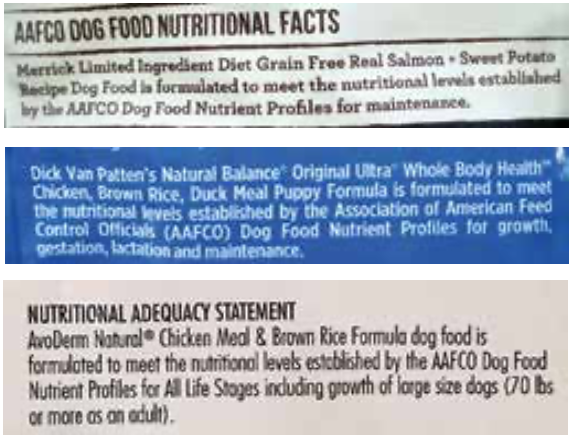
If there is one thing that everyone knows, it’s that you have to start out puppies on puppy food. And then at some point later, maybe when the pup is a year old, you can switch him over to adult food. Right?
Well, no. There’s a bit more to it than that.
Let’s get the easy part sorted out first. Generally speaking, a dog is considered an adult when they reach full size, on average around 1 year of age. Small-breed dogs mature faster and can be considered an adult around 9 to 10 months of age. Large breed dogs mature more slowly; it may take them until 18 months or more to stop growing.
PUPPIES HAVE GREATER NEEDS
Growing puppies have greater nutritional needs than adult dogs. They require more calories per pound of body weight than adults – and they need a diet that contains a higher percentage of fat and protein (including higher amounts of many specific amino acids that contribute to the food’s total protein) than adult dogs. Their needs for calcium, phosphorus, and several other minerals are also higher than the amounts needed by adult dogs.
The legal minimum (and a few maximum) values for the nutrient requirements of puppies and adult dogs are enumerated in tables (called “nutrient profiles”) established by the Association of American Feed Control Officials (AAFCO). One column lists the nutrient levels required for the “maintenance” of adult dogs; these are called the “adult maintenance” nutrient profiles. Another column lists the nutrient levels that meet the needs of breeding animals, pregnant or nursing females, and growing puppies. These are called the “growth and reproduction” nutrient profiles.
The phrase “puppy food” isn’t the guarantee of a product’s nutritional adequacy. Rather, it’s the “AAFCO nutritional adequacy statement” that indicates whether the food meets the legal requirements of a “complete and balanced diet” for puppies. If it does, the statement will either say the food is formulated to meet the nutritional levels established by the AAFCO Dog Food Nutrient Profiles “for growth” or “for all life stages.” AAFCO now requires that foods also specify whether they are appropriate for large-breed puppies with a statement that uses either “including” or “except for” the growth of large size dogs (70 lbs. or more as an adult).
“ALL” INCLUDES PUPPIES
Remember, there are only two Nutrient Profiles: one for “growth and reproduction” and one for “adult maintenance” (sometimes called just “maintenance”). So what’s this about “all life stages”?
“All life stages” includes growth and reproduction; a food that is so labeled must meet the requirements for puppies. Whether you feed a product that is formulated for “growth” or for “dogs of all life stages” – which, again, is the same thing – you could feed that product from weaning through your dog’s senior years. “Puppy food” may be manufactured with a smaller kibble size, but, nutritionally, it can be fed to a dog of any life stage.
ADULTS ONLY
The Adult Maintenance Nutrient Profiles have lower minimum values for protein and fat, so they usually contain less protein and fat. Protein and fat are the most expensive ingredients in a food, so if the manufacturer can put less of them in a product, they usually do. Less fat also means fewer calories.
You may want to consider switching your dog to a “maintenance” food if he’s both (1) fully grown and (2) overweight or gaining unneeded weight on the same amount of food you’ve always fed. Or, keep feeding an “all life stages” food, and just feed less of it!






We foster dogs and puppies. We have heard that feeling large breed puppy food gives malnourished you g puppies and dogs a better nutritional profile—is this accurate?
Read this article: https://qa.whole-dog-journal.com/puppies/puppy-needs-new-food/
Food that is formulated for puppies who are expected to grow to more than 70 lbs (large-breed puppy food) contains lower amounts of protein, fat, and several other nutrients than foods that are formulated for smaller puppies.
I couldn’t begin to address what previously malnourished puppies should be eating; I don’t know whether higher or lower amounts of protein or fat are best for them. I could ask a veterinary nutrition expert, if you’d like.
Nancy Kerns, Editor
I have two rescued puppies, mixed Chihuahuas, both are about 5 months old, and I adopted them on March 6th of this year. I’ve tried 4 different puppy foods, and they have loose stools. They have both had fecal exams with my Vet which were both negative. They have also had their second Simparacatrio
chewable tablets, and I realized that one of the side effects of this medication is diarrhea. I don’t plan on having my Vet continue this medication. What medication do you recommend, and which puppy food do you recommend for loose bowels. I prefer either salmon or chicken.
Thanks, Marci Goldberg
I’m sorry, but I can’t make specific recommendations for diets for individual dogs.
If your dog has a health issue that requires a dietary adjustment of some kind, it’s important to find a veterinarian who is knowledgeable about nutrition to help you find something appropriate.
Nancy Kerns, Editor
Whole Dog Journal
We have a Bernedoodle that at 7 months is 42 lbs…how do I know if he should be eating small breed or large breed food? We had a Goldendoodle that was supposed to be 45-55 lbs but landed at 97, healthy weight. I worry that he is not getting the correct nutrition.
Hi, a German Shepherd breeder has told us that recent evidence suggest that GSD puppies should NOT be fed large breed puppy food as this has been linked to them growing too fast and this leading to more hip and elbow problems. Are you aware of any research that supports this? Thanks!
I use the WDJ dog food databases extensively to investigate new/different food for y dog’s diet rotation. It would be great if the databases (dry and wet) included whether the food meets the AAFCO standard for growth of large breed puppies. Often times, it’s very difficult to find the AAFCO statement when shopping on-line. Either the photos of the food don’t show the AAFCO statement or it’s so small that you can’t even zoom in enough to read it. thanks!